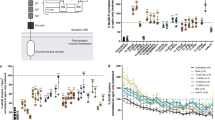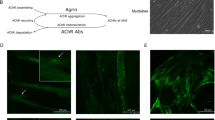Abstract
The muscular weakness and fatigability associated with myasthenia gravis are engendered by autoantibodies directed against acetylcholine receptors on muscle cells at neuromuscular junctions. The pathogenic consequences of this immune response can potentially be modulated by molecules that bind such autoantibodies and block their interaction with these receptors. We report the isolation of a small nuclease-resistant RNA molecule that binds both a rat monoclonal antibody that recognizes the main immunogenic region on the acetylcholine receptor, and autoantibodies from patients with myasthenia gravis. Moreover, this RNA can act as a decoy and protect acetylcholine receptors on human cells from the effects of these antibodies.
This is a preview of subscription content, access via your institution
Access options
Subscribe to this journal
Receive 12 print issues and online access
$209.00 per year
only $17.42 per issue
Buy this article
- Purchase on Springer Link
- Instant access to full article PDF
Prices may be subject to local taxes which are calculated during checkout
Similar content being viewed by others
References
Lindstrom, J., Shelton, D., and Fujii, Y. 1988. Myasthenia gravis. Adv. Immunol. 42: 233–284.
Wilcox, N. 1993. Myasthenia gravis. Curr. Opin. Immunol. 5: 910–917.
Drachman, D.B. 1994. Myasthenia gravis. N. Engl. J. Med. 330: 1797–1810.
Patrick, J. and Lindstrom, J.M. 1973. Autoimmune response to acetylcholine receptor. Science 180: 871–872.
Fambrough, D.M., Drachman, D.B., and Satiamurti, S. 1973. Neuromuscular junction in myasthenia gravis: decreased acetylcholine receptors. Science 182: 293–295.
Tzartos, S.J., Rand, D.E., Einarson, B.L., and Lindstrom, J.M. 1981. Mapping of surface structures of electrophorous acetylcholine receptor using monoclonal antibodies. J. Biol. Chem. 256: 8635–8645.
Tzartos, S.J., Seybold, M.E., and Lindstrom, J.M. 1982. Specificities of antibodies to acetylcholine receptors in sera from myasthenia gravis patients measured by monoclonal antibodies. Proc. Natl. Acad. Sci. USA 79: 188–192.
Sullenger, B.A., Gallardo, H.F., Lingers, G.E., and Gilboa, E. 1990. Overexpression of TAR sequences renders cells resistant to human immunodeficiency virus repli-cation. Cell 63: 601–608.
Sullenger, B.A., Gallardo, H.F., Lingers, G.E., and Gilboa, E. 1991. Analysis of TAR decoy RNA mediated inhibition of HIV-1 transactivation. J. Virol. 65: 6811–6816.
Lisziewicz, J., Rappaport, J., and Dhar, R. 1991. Tat-regulated production of multimerized TAR RNA inhibits HIV-1 gene expression. New Biol. 3: 82–89.
Lee, S.-W., Gallardo, H.F., Gilboa, E., and Smith, C. 1994. Inhibition of HIV-1 in human T-cells by a potent RRE decoy comprised of the 13 nucleotide-long minimal rev binding domain. J. Virol. 68: 8254–8264.
Lee, S.-W., Gallardo, H.F., Gasper, O., Smith, C., and Gilboa, E. 1995. Inhibition of HIV-1 in GEM cells by a potent TAR decoy. Gene Ther. 2: 377–384.
Gold, L., Alien, P., Binkley, J., Brown, D., Schneider, D., Eddy, S.R. et al. 1993. RNA: the shape of things to come, pp. 497–510 in The RNA world. Gestelend, R.F. and Atkins, J. F. (eds.). Cold Spring Harbor Press, Cold Spring Harbor, NY.
Gold, L., Polisky, B., Uhlenbeck, O.C., and Yarus, M. 1995. Diversity of oligo-nucleotide functions. Annu. Rev. Biochem. 64: 763–795.
Tuerk, C. and Gold, L. 1990. Systematic evolution of ligands by exponential enrichment: RNA ligands to bacteriophage T4 DNA polymerase. Science 249: 505–510.
Joyce, G.F., 1989. Amplification, mutation and deletion of catalytic RNA. Gene 82: 83–87.
Szostak, J.W. 1992. In vitro genetics. Trends Biochem. Sci. 17: 89–93.
Tsai, D.E., Kenan, D.J., and Keene, J.D. 1992. In vitro selection of an RNA epitope immunologically cross-reactive with a peptide. Proc. Natl. Acad. Sci. USA 89: 8864–8868.
Doudna, J.A., Cech, T.R., and Sullenger, B.A. 1995. Selection of an RNA molecule that mimics a major autoantigenic epitope of human insulin receptor. Proc. Natl. Acad. Sci. USA 92: 2355–2359.
Lee, S.-W. and Sullenger, B.A. 1996. Isolation of a nuclease-resistant decoy RNA that selectively blocks autoantibody binding to insulin receptors on human lymphocytes. J. Exp. Med. 184: 315–324.
Saedi, M.S., Anand, R., Conroy, W.G., and Lindstrom, J.M. 1990. Determination of amino acids critical to the main immunogenic region of intact acetylcholine receptors by in vitro mutagenesis. FEBS Lett. 267: 55–59.
Pieken, W.A., Olsen, D.B., Benseler, F., Aurup, H., and Eckstein, F. 1991. Kinetic characterization of ribonuclease-resistant 2′-modified hammerhead ribozymes. Science 253: 314–317.
Jellinek, D., Green, L.S., Bell, C., Lynott, C.K., Gill, N., Vargeese, C. et al. 1995. Potent 2′amino-2′deoxy RNA inhibitors of basic fibroblast growth factor. Biochemistry 34: 11363–11372.
Sophianos, D. and Tzartos, S. 1989. Fab fragments of monoclonal antibodies pro-tect the human acetylcholine receptor against antigenic modulation caused by myasthenia gravis. J. Autoimmun. 2: 777–789.
Mamalaki, A., Trakas, N., and Tzartos, S.J. 1993. Bacterial expression of a single-chain Fv fragment which efficiently protects the acetylcholine receptor against antigenic modulation caused by myasthenic antibodies. Eur. J. Immunol. 23: 1839–1845.
Stanley, E.F. and Drachman, D.B. 1978. Effect of myasthenic immunoglobulin of acetylcholine receptors of intact mammalian neuromuscular junctions. Science 200: 1285–1287.
Kao, I. and Drachman, D.B. 1977. Myasthenic immunoglobulin accelerates acetylcholine receptor degradation. Science 196: 527–529.
Heineman, S., Beven, S., Kullberg, R., Lindstrom, J.M., and Rice, J. 1977. Modulation of acetylcholine receptor by antibody against the receptor. Proc. Natl. Acad. Sci. USA 74: 3090–3094.
Drachman, D.B., Adams, R.N., Josifek, L.F., and Self, S.G. 1982. Functional activities of autoantibodies to acetylcholine receptors and the clinical severity of myasthenia gravis. N. Engl. J. Med. 307: 769–775.
Jaeger, J., Turner, D., and Zuker, M. 1989. Improved predictions of secondary structures for RNA. Proc. Natl. Acad. Sci. USA 86: 7706–7710.
Vincent, A., Whiting, P.J., Schluep, M., Heidenreich, F., Lang, B., Roberts, A., et al. 1987. Antibody heterogeneity and specificity in myasthenia gravis. Ann. N.Y. Acad. Sci. 505: 106–120.
Lennon, V.A., Lambert, E.H., Leiby, K.R., Okarma, T.B., and Talib, S. 1991. Recombinant human acetylcholine receptor α-subunit induces chronic experimental autoimmune myasthenia gravis. J. Immunol. 146: 2245–2248.
Stratton, M.R., Darling, J., Pikington, G.J., Lantos, P.L., Reeves, B.R., and Cooper, C.S. 1989. Characterization of the human cell line TE671. Carcinogenesis 10: 899–905.
Luther, M.A., Schoepfer, R., Whiting, R., Casey, B., Blatt, Y., Montal, M.S., Montal, M., et al. 1989. A muscle acetylcholine receptor is expressed in the human cere-bellar medulloblastoma cell line TE671. J. Neurosci. 9: 1082–1096.
Author information
Authors and Affiliations
Rights and permissions
About this article
Cite this article
Lee, SW., Sullenger, B. Isolation of a nuclease-resistant decoy RNA that can protect human acetylcholine receptors from myasthenic antibodies. Nat Biotechnol 15, 41–45 (1997). https://doi.org/10.1038/nbt0197-41
Received:
Accepted:
Issue Date:
DOI: https://doi.org/10.1038/nbt0197-41
This article is cited by
-
Aptamers as therapeutics
Nature Reviews Drug Discovery (2010)
-
Translating Nucleic Acid Aptamers to Antithrombotic Drugs in Cardiovascular Medicine
Journal of Cardiovascular Translational Research (2010)



